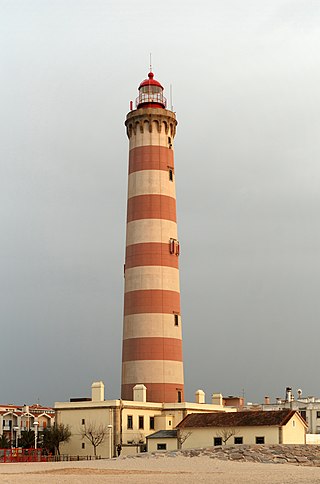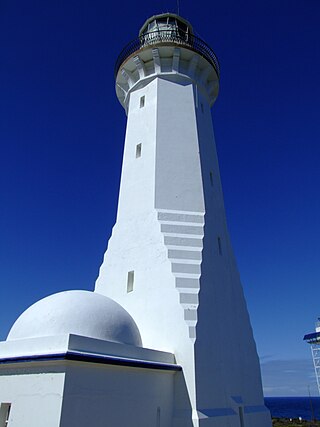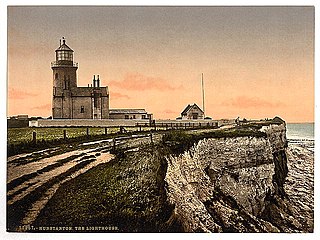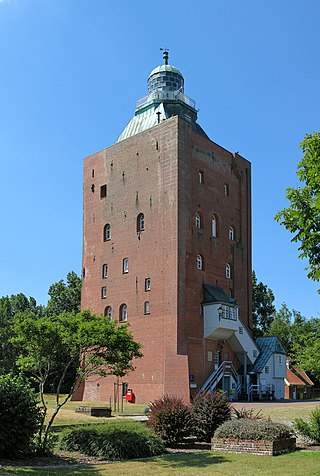Related Research Articles

Harwich is a town in Essex, England, and one of the Haven ports on the North Sea coast. It is in the Tendring district. Nearby places include Felixstowe to the north-east, Ipswich to the north-west, Colchester to the south-west and Clacton-on-Sea to the south. It is the northernmost coastal town in Essex.

A lighthouse is a tower, building, or other type of physical structure designed to emit light from a system of lamps and lenses and to serve as a beacon for navigational aid, for maritime pilots at sea or on inland waterways.

Perejil Island, also known as Parsley Island, is a small, uninhabited rocky islet located 200 metres (660 ft) off the coast of Morocco. It is administered by Spain as one of the plazas de soberanía, and its sovereignty is disputed by Morocco. It was the subject of an armed incident between the two countries in 2002.
Mainland is defined as "relating to or forming the main part of a country or continent, not including the islands around it [regardless of status under territorial jurisdiction by an entity]." The term is often politically, economically and/or demographically more significant than politically associated remote territories, such as exclaves or oceanic islands situated outside the continental shelf.

The Thames Estuary is where the River Thames meets the waters of the North Sea, in the south-east of Great Britain.

Gorizia was the third member of the Zara class of heavy cruisers to be built for the Italian Regia Marina in the 1930s. Named for the town of Gorizia, the ship was laid down at the OTO Livorno shipyard in March 1930, was launched in December that year and was commissioned into the fleet in December 1931. Armed with a main battery of eight 8-inch (200 mm) guns, she was nominally within the 10,000-long-ton (10,000 t) limit imposed by the Washington Naval Treaty, though in reality she significantly exceeded this figure.

Hayreddin Barbarossa, also known as Hayreddin Pasha, Hızır Hayrettin Pasha, and simply Hızır Reis, was an Ottoman corsair and later admiral of the Ottoman Navy. Barbarossa's naval victories secured Ottoman dominance over the Mediterranean during the mid-16th century.

A lighthouse keeper or lightkeeper is a person responsible for tending and caring for a lighthouse, particularly the light and lens in the days when oil lamps and clockwork mechanisms were used. Lighthouse keepers were sometimes referred to as "wickies" because of their job trimming the wicks.

Point Arguello Lighthouse is a lighthouse on Point Arguello in Santa Barbara County, California, serving the Santa Barbara Channel on the Gaviota Coast adjoining Vandenberg Space Force Base near the city of Lompoc, California.

The Green Cape Lighthouse is a heritage-listed lighthouse located at the tip of Green Cape, a headland forming the northern boundary of Disaster Bay, in southern New South Wales, Australia. It is the southernmost lighthouse in New South Wales and Australia's first lighthouse built in concrete. At 29 metres (95 ft) it is also the tallest lighthouse in New South Wales. It marks Green Cape on the northerly shore-hugging sailing course.

Old Hunstanton Lighthouse is a former lighthouse located in Old Hunstanton in the English county of Norfolk, generally called Hunstanton Lighthouse during its operational life. It was built at the highest point available on this part of the coast, on top of Hunstanton Cliffs, and served to help guide vessels into the safe water of Lynn Deeps. Although the present lighthouse was built in 1840, there had been a lighthouse on the site since the 17th century. Prior to the establishment of the Lynn Well light vessel in 1828, Hunstanton Lighthouse provided the only visible guide to ships seeking to enter The Wash at night.

Winterton Lighthouse is located in Winterton-on-Sea in the English county of Norfolk. In 1845 Winterton Ness was described as being 'well known to the mariner as the most fatal headland between Scotland and London'. As well as marking the headland, the lighthouse was intended to help guide vessels into the Cockle Gat, which provided the northern entry into the safe water of Yarmouth Roads. The lighthouse was known to Daniel Defoe and is mentioned in his novel Robinson Crusoe.

The Península de Almina is a peninsula making up much of the eastern part of the Spanish city of Ceuta in Africa. It is dominated by the peak of Monte Hacho. The peninsula contains Ceuta's easternmost point, Punta Almina, and is connected to the rest of Ceuta by an isthmus barely 100 metres (330 ft) in width.

The Round Tower was a lighthouse in Burnham-on-Sea, Somerset, England, established in 1801. It was decommissioned in 1832, having been replaced by a pair of leading lights half a mile to the north, and is now a private dwelling.

Lady Elliot Island Light is an active lighthouse located on Lady Elliot Island, the southernmost coral cay of the Great Barrier Reef, 46 nautical miles north-east of Bundaberg, Queensland, Australia. The lighthouse is located on the western side of the island. It was the third lighthouse erected in Queensland after its formation in 1859 and the first in Australia to be constructed of a timber frame clad with iron plates. The original lighthouse was deactivated in 1995 and the light was replaced by a modern skeletal tower standing close to the original lighthouse.

Low Point Lighthouse is an historic Canadian lighthouse marking the eastern entrance to Sydney Harbour at New Victoria, Nova Scotia, near New Waterford, Nova Scotia. This is one of the earliest and most important light stations of Nova Scotia, one of the first dozen beacons in Nova Scotia to be lit to guide mariners, a classic red-and-white lighthouse still operated by the Canadian Coast Guard.

The Europa Point Lighthouse, also referred to as the Trinity Lighthouse at Europa Point and the Victoria Tower or La Farola in Llanito, is a lighthouse at Europa Point, on the southeastern tip of the British Overseas Territory of Gibraltar, on the southern end of the Iberian Peninsula, at the entrance to the Mediterranean Sea.

John Purdy (1773–1843) was an important English hydrographer. His work and influence extended beyond hydrography with the coinage of the term pharology, the study of modern lighthouses and their designs. Purdy's work Memoir, descriptive and explanatory, to accompany the New Chart of the Atlantic Ocean was adapted and improved; continuing to be released in its fifteenth edition fifty years after his death.

The Great Tower Neuwerk is the most significant building of the Neuwerk island, belonging to Hamburg. Completed in 1310, the structure is one of the oldest worldwide that was used as lighthouse (1814–2014) and still standing. This former beacon, watchtower and lighthouse is also the oldest building in Hamburg and oldest secular building on the German coast.
References
- ↑ Purdy, John (1839). The Colombian Navigator; Or, Sailing Directory for the American Coasts and the West-Indies.
- ↑ Purdy, John (1840). The New Sailing Directory for the Strait of Gibraltar and the Western Division of the Mediterranean Sea: Comprehending the Coasts of Spain, France, and Italy, from Cape Trafalgar to Cape Spartivento, the Balearic Isles, Corsica, Sardinia, Sicily and the Maltese Islands, with the African Coast, from Tangier to Tripoli, Inclusive ... Improved, by Considerable Additions, to the Present Times. R.H. Laurie.
- ↑ The Nautical Magazine: A Journal of Papers on Subjects Connected with Maritime Affairs, Volume 13. Brown, Son and Ferguson. 1844.
- ↑ "Pharology". World Wide Web Words. Retrieved 2 December 2013.
- ↑ Findlay, Alexander (1864). A description and list of the lighthouses of the world, 1861.
- ↑ "pharology" The Oxford English Dictionary, 2nd ed., 1989, OED Online, Oxford University Press, (subscription needed) 1 Jan. 2010.
- 1 2 3 4 Barkham, Patrick (14 July 2008). "Light fantastic - Patrick Barkham sheds light on Pharology". The Guardian. Retrieved 2 December 2013.
- ↑ The Alumni Quarterly and Fortnightly Notes of the University of Illinois, Volume 4. University of Illinois. 1918. Retrieved 2 December 2013.
- ↑ Douglas Hague and Rosemary Christie. Lighthouses: Their Architecture, History and Archaeology, Gomer Press (1975)
- ↑ Kenneth Sutton-Jones. Pharos: The Lighthouse Yesterday Today and Tomorrow, Michael Russell, Salisbury UK (1985)
- ↑ Jean Guichard, Ken Trethewey. North Atlantic Lighthouses, Flammarion, Paris (2002)
- ↑ Toby Chance, Peter Williams. Lighthouses: The Race to Illuminate the World, New Holland Publishers (UK), (2008)
- ↑ James, Paul (2016-05-23). "Alan Yates Says Rift's Core Features Are a "Direct Copy" of Valve's VR Research – Road to VR". Road to VR. Retrieved 2017-06-30.
- ↑ Joe Holley (September 24, 2005). "F. Ross Holland Jr., 78, Dies; Historian of U.S. Lighthouses". The Washington Post .
- ↑ Peter Gellatly. Following The Lights, Author, Scotland (2018)
